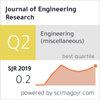Efficient resource allocation through CNN-game theory based network slicing recognition for next-generation networks
IF 0.9
4区 工程技术
Q3 ENGINEERING, MULTIDISCIPLINARY
引用次数: 0
Abstract
Fifth generation (5G) and sixth generation (6G) networks are examples of next-generation networks that need higher levels of safety, lower latency, and more capacity and dependability. Reconfigurable wireless connection slicing becomes essential for satisfying these sophisticated networks' requirements, enabling many network instances on the same hardware to improve Quality of Service (QoS). Nonetheless, the centrally managed resource allocation for network slicers presents difficulties, particularly as the quantity of User Equipment (UEs) increases. This puts pressure on Radio Resource Management (RRM) and makes slice customization more difficult. In order to address these issues, this study presents an organizational radio resource distribution architecture in which the neighborhood radio resource managers (LRRMs) receive sub channel allocations from the RRM in slices, and the LRRMs then distribute the assigned capabilities to the corresponding UEs. The suggested model, which runs in MATLAB, uses an original method called CNN-Game Theory to achieve an exceptional 98 % accuracy, outperforming CNN-LSTM, RNN, DeepCog, and DHOA by 29.27 %. This method combines ideas from game theory with neural network weight optimization to produce an improved model with increased efficiency and accuracy. Many experiments illustrate how effective this method is and how it can be used to improve different machine learning applications. Metrics like slice type utilization, average packet delay for each LTE/5G category, and others are used to assess game optimization for resource allocation
通过基于 CNN-博弈论的网络切片识别实现下一代网络的高效资源分配
本文章由计算机程序翻译,如有差异,请以英文原文为准。
求助全文
约1分钟内获得全文
求助全文
来源期刊

Journal of Engineering Research
ENGINEERING, MULTIDISCIPLINARY-
CiteScore
1.60
自引率
10.00%
发文量
181
审稿时长
20 weeks
期刊介绍:
Journal of Engineering Research (JER) is a international, peer reviewed journal which publishes full length original research papers, reviews, case studies related to all areas of Engineering such as: Civil, Mechanical, Industrial, Electrical, Computer, Chemical, Petroleum, Aerospace, Architectural, Biomedical, Coastal, Environmental, Marine & Ocean, Metallurgical & Materials, software, Surveying, Systems and Manufacturing Engineering. In particular, JER focuses on innovative approaches and methods that contribute to solving the environmental and manufacturing problems, which exist primarily in the Arabian Gulf region and the Middle East countries. Kuwait University used to publish the Journal "Kuwait Journal of Science and Engineering" (ISSN: 1024-8684), which included Science and Engineering articles since 1974. In 2011 the decision was taken to split KJSE into two independent Journals - "Journal of Engineering Research "(JER) and "Kuwait Journal of Science" (KJS).
 求助内容:
求助内容: 应助结果提醒方式:
应助结果提醒方式:


